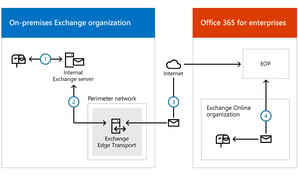New Hybrid Configuration Wizard features in Exchange 2013 CU5
As mentioned in a prior blog post, Microsoft released Cumulative Update 5 (CU5) for Exchange 2013....


With IT/DEV Connections less than two weeks out, I found myself getting anxious to attend these insightful sessions.
The conference, which happens to be one of my favorites, has many advantages: it’s not as hectic as Ignite, and the smaller crowd gives you the opportunity to interact with all the great speakers.
As usual, it's held in Las Vegas from September 14 – 17 in the beautiful Aria hotel. It doesn’t get much better than that!

Although Exchange is my “first love,” Office 365 is much more than only Exchange Online. IT/DEV connections gives you the ability to learn about other important workloads like SharePoint and Azure, all within the setting of the smaller-scale but highly-focused conference.
So with all this excitement building up, I decided to post my thoughts on each of the sessions. Please feel free to comment about which ones you’re looking forward to most!
Despite the fact that PowerShell has been around for a while, many administrators still struggle with PowerShell (or they are only starting to learn about it). This workshop is delivered by two experts in their field, including Michel de Rooij who has published an arsenal of SUPER great scripts like the Exchange 2013 Unattended installation script or, more recently, the Office 365 Connection script.
This is the ideal start to a conference. Hear “the godfather of Exchange” talk about where Exchange and Exchange online are in the world today and where the world is (slowly) moving toward. It definitely sets the tone for the conference.
Managed Availability has always been a black box. And wouldn’t it be interesting to finally figure out what it’s doing for you instead of just wondering what’s happening in your environment?
Even though Exchange 2016 hasn’t been officially released, this session will provide you with lots of insights from the infamous Jeff Guillet who has a TON of experience with all versions of Exchange.
Every security-conscious administrator should attend this session if you are seriously thinking about deploying MFA with Exchange (or Skype).
It’s easy to get lost in the overwhelming amount of data and information that gets thrown at us. Knowing how to visualize data and thus make your life easier seems like a good thing to know!
Even though the default settings of Exchange Online ought to work for the majority of the customers, that may or may not be the case for you. Mike Crowley is going to walk you through some of the finer details of Exchange Online Protection, including newer features such as Advanced Threat Protection.
After learning how to install Exchange 2016 from Jeff, Paul will tell you everything there is to know to keep your Exchange 2016 servers running happily ever after. Did Microsoft improve Managed Availability? Find out here!
What storage option to choose for Exchange has always been a hot topic and the center of many (un)healthy discussion. Especially if you throw virtualization into the mix, things can heat up quite quickly… Andrew is one of the sources of authority with a TON of experience in this field. Definitely worth going to!
Exchange 2016 has simplified the process of dealing with namespaces. But does this also apply to load balancing? Bhargav, who works for KEMP (a load balancer brand!) will tell you everything you need to know to successfully load balance Exchange 2016!
Tim works for Microsoft as a Sr. Support Escalation Engineer. As a result, he gets to see A LOT of things that go wrong out there in the real world. More often than not, the problem stems from components at the customer’s side. If you want to know the intricacies of dealing with office 365 and want to understand what to look out for, I’m sure this session is for you!
If you have to support Exchange 2013 and want to learn a few tricks on how to troubleshoot Exchange issues, Andrew – who works at Dell as a principal engineer - is the man to talk to.
Office 365 offers some basic, built-in mobile device management features but can also be extended with more capabilities through Intune. If you want to find out what Office 365 can and cannot do for your mobile devices, you’ll want to check this one out!
Security is a key concern in today’s world. News of hacks or data leaks is never far away. If you want to learn how Office 365 can protect your data, this session is for you!
This session is not a PowerShell-only session. Instead, you will learn the various options available and how you can automate recurring tasks. If you are tired of doing repetitive tasks, but aren’t sure on how to tackle these, come by and see me!
Paul Cunningham, better known as ExchangeServerPro will share his top tips to keeping your DAGs healthy. And to be fair, who doesn’t want a DAG to be in top shape?
If you are new to PowerShell (or Office 365), Mike will set you on your way and show you how to effectively manage Exchange Online through PowerShell.
Not so long ago, Microsoft announced support for running Exchange 2013 in Azure. One of the use cases of Azure is beefing up the resiliency of your deployment by adding servers in Azure. But is it a good idea? If so, what are the things to take into account? Tim will tell you all about it!
Although Office 365 has been around for a while, many questions have been left unanswered. Not anymore after this session!
Today, there are many options for managing identities and authentication in Microsoft’s Online Services. In this session, I’ll cover these as well as the different authentication options. An ideal session to find out what you can/cannot or should and should not do!
PowerShell DSC for Exchange is a very under-utilized feature. But is it rightfully so? Brian will explain what it takes to use DSC to configure Exchange environment and share his thoughts on the good, the bad and the ugly!
Jeff’s been working with Exchange for a long time. He has a vast amount of experience designing, deploying and troubleshooting Exchange. If you want to learn what you definitely should avoid doing in an Exchange migration, this session is where you want to be.
Backups and Exchange, it’s a combination that have caused headaches for many Exchange administrators. And who has not had (or heard of) the discussion about whether or not backups for Exchange are still required? If you want to find out if you still need your backups and what to do if you don’t, go to this session.
Next to the Mobile Device Management features in Office 365, there is a LOT you can do with the built-in Exchange ActiveSync capabilities. In this session, Paul shares his thoughts and experiences with ActiveSync and some of the underutilized features like Allow/Block/Quarantine policies or PowerShell reports.
Telnet is a very valuable tool for troubleshooting purposes. If you don’t use it, don’t know how to use it or aren’t convinced it can be a modern troubleshooting tool, definitely attend this session!
If you plan on moving to Office 365 or if you already manage an Office 365 tenant, you will learn about the key tasks involved in doing so successfully.
Not only will there be a panel of experts, but many of the speakers will also likely be in the room, too. This is your opportunity to ask the questions you haven’t had answered yet!
What are your thoughts on the sessions? Which ones are you looking forward to most? I’d love to hear your thoughts in the comments!

Michael Van Horenbeeck is a Microsoft Certified Solutions Master (MCSM) and Exchange Server MVP from Belgium, with a strong focus on Microsoft Exchange, Office 365, Active Directory, and a bit of Lync. Michael has been active in the industry for about 12 years and developed a love for Exchange back in 2000. He is a frequent blogger and a member of the Belgian Unified Communications User Group Pro-Exchange. Besides writing about technology, Michael is a regular contributor to The UC Architects podcast and speaker at various conferences around the world.


As mentioned in a prior blog post, Microsoft released Cumulative Update 5 (CU5) for Exchange 2013....


When it comes to sizing a typical on-premises Exchange Server deployment, Microsoft has really gone...